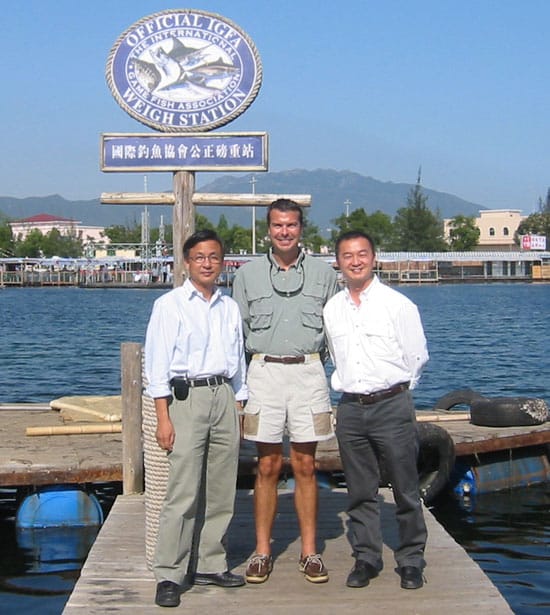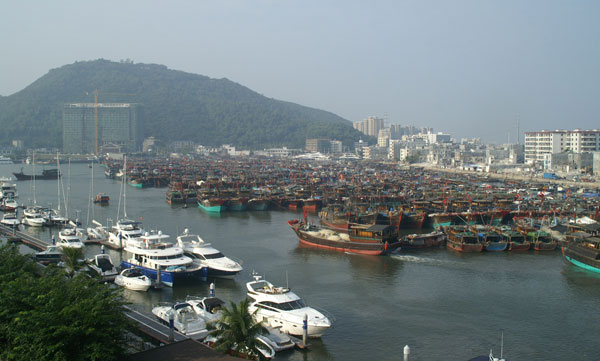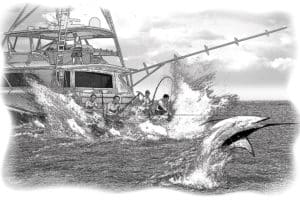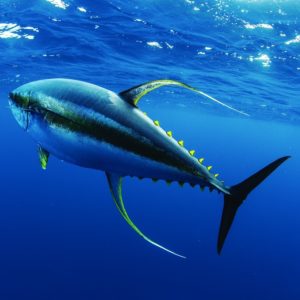
kreamer blog
I knew it would happen sooner or later. During my previous visit to South China for a speaking engagement nearly eight years ago, I saw where things were headed. Nearly everywhere I looked, I saw signs of a rapidly developing economy and a population with an increasing disposable income, not an insignificant portion of which was being applied to “western recreation” – including fishing.
During my first trip, I visited several “recreational” fishing operations (both freshwater and saltwater) that were quite impressive, including the one pictured here that is located south of the city of Shenzhen. On either side of me and standing in front of the IGFA Weigh Station sign are the two business partners who owned the operation (on my right is IGFA Representative Eric Leung from Hong Kong). The covered docks behind us were divided into meter-wide spaces, all numbered. People wishing to fish paid to get in to fish on a numbered spot, paid for the fish they caught, and then, if they so desired, paid to have it cooked in the restaurant on the left side of the picture. The saltwater pond was stocked with cobia, snapper and grouper, all harvested from local fish farms.
At the time of my first trip, coastal boating was highly regulated, but there were signs everywhere that this would soon change. We visited several brand new hotel resort complexes with fantastic golf courses and very large state-of-the-art marinas. Some of the slips were designed to accommodate boats well over 200 feet. However, nearly all of the slips were vacant, with the exception of a few poorly maintained pleasure boats and a couple of small commercial fishing vessels.
But in eight years things have changed dramatically. On this trip I saw privately owned boats everywhere, including a number of mega-yachts. In the past year, IGFA has added four new member clubs/associations in China, and there is incredible interest in developing an offshore recreational fishing industry…..now. This was what prompted my second journey to the other side of the planet early this month.
I have discovered that they do nothing halfway in China. One just has to walk into the new 986,000-square-meter terminal No. 3 at the Beijing Airport that was built to handle the additional air traffic associated with the 2008 Olympics (http://en.wikipedia.org/wiki/Beijing_Capital_International_Airport) to see this firsthand. The phrase “city within a city” immediately comes to mind. China has a very lithe economy made up of businesses that capitalize on speed and the ability to adapt. In addition to cheap labor and minimal regulatory laws, this is one of the characteristics that has led to the huge amount of export manufacturing in China. It was clear early on in my trip that this philosophy will also apply to their approach to developing an offshore recreational fishing industry.
So at the request of the Hainan Game Fish Association (Hainan Province in the South China Sea), IGFA assembled a team to take a cursory look at their infrastructure and provide guidance on how they might begin developing not just an offshore recreational fishing industry, but a sustainable one that fully understood and considered resource conservation. Our delegation was comprised of myself, IGFA Conservation Director Jason Schratwieser, IGFA COO and Corporate Relations Director Mike Myatt and IGFA Representative Capt. Karl Anderson, who would help evaluate marina facilities and a local boat-building facility. Although there is much work to be done, our hosts seemed quite keen on jumping right to the idea of hosting an international offshore fishing tournament – difficult in even the most established offshore recreational fishing destinations. However, being the appreciative guests that we were, we began to provide insight and analysis on just what would be required to actually pull off a major international fishing tournament.

Some of the things we agreed to inspect were: hotels, marinas, restaurants, airports, ground transportation, boats and, most important, the fishery. To date, everything is at least adequate and in place in this one region…..except for the last two “little” items. We inspected one boat manufacturing company that was just now considering how to modify production to produce boats designed to fish, as opposed to just pleasure crafts. They have the potential, but have much to learn. We do not know about any other facilities that may exist in other parts of China. We had only one day scheduled to actually fish, and due to poor weather and technical problems with the boat, we still have no idea whether there are any game fish to be had in the region of South Hainan. We were shown pictures of a few marlin and sailfish, but a picture isn’t going to convince international anglers to suddenly descend on South China. We also made it clear that it will not only take time and extensive effort to verify whether or not an adequate fishery exists to support international tourism, but it cannot be done with their current local boats, captains and crews. Our hosts seemed to take this all in stride, conveying a confident and pleased attitude with regards to this “minor detail.”
When many people think of coastal China, images of extremely dense populations extracting every last living thing from the sea to survive come to mind. While this is not the case, we did see signs that coastal commercial fishing may be a far bigger issue than we had anticipated….far bigger. The port in Sanya from which we departed for our hapless day of fishing was absolutely choked with commercial fishing vessels whose decks were piled high with gill nets (see photo). This, we told our guests, was a problem. Even if these boats were not having a deleterious effect on the offshore fishery, few international anglers would be content with having to weave through this ominous armada to get to the fishing grounds. If there were no fish that day, these guys would get the blame – regardless.
Whether these challenges can be overcome by our friends in China remains to be seen. There is no denying the potential market and there is no denying the potential opportunity to responsibly expand recreational fishing in the world via China. So much like the missionaries venturing into unknown lands to do good, our team at IGFA will continue to provide advice and guidance to groups in China on how best to create a sustainable and responsible recreational fishing industry.
For more photos of the 2011 IGFA China Expedition click on: http://www.igfa.org/travel/china/igfainchina.aspx







